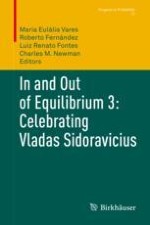
2021 | OriginalPaper | Chapter
Existence and Coexistence in First-Passage Percolation
Author : Daniel Ahlberg
Published in: In and Out of Equilibrium 3: Celebrating Vladas Sidoravicius
Publisher: Springer International Publishing
Activate our intelligent search to find suitable subject content or patents.
Select sections of text to find matching patents with Artificial Intelligence. powered by
Select sections of text to find additional relevant content using AI-assisted search. powered by